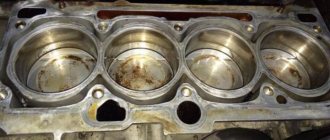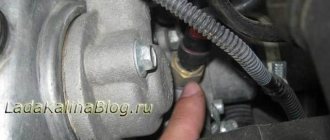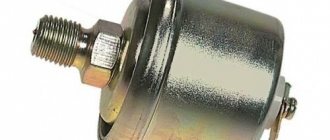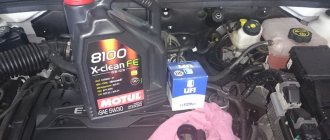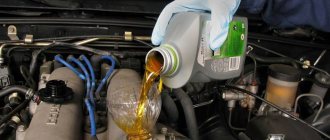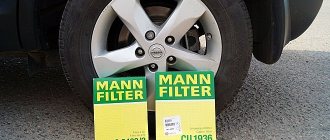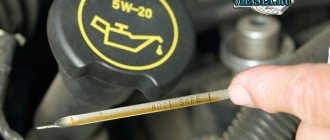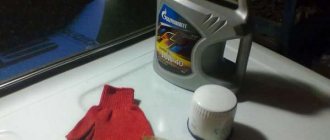Changing the engine oil is one of the most important stages in car maintenance. Practice shows that in most cases, increasing the frequency of oil changes can cause serious engine problems. As a result, saving on oil will result in serious costs for engine repairs.
The oil and oil filter on a new engine should be replaced after the first 1,500-2,000 km and then after every 5,000-10,000 km for domestic and 10,000-15,000 km for imported oils (but at least once a year).
We have previously written about what kind of oil is best to pour into the engine and whether flushing the engine is necessary when changing the oil. The procedure for changing engine oil itself is not very complicated, so many car enthusiasts can do it themselves.
Changing the engine oil
When changing the oil, it is advisable to first install a new oil filter. It is recommended to fill it with lubricant before installation. The volume is about a third of the filter.
The next sequence of actions is as follows:
- Wipe the rubber seal with oil.
- The part is then fastened into place.
- After this, the filler plug is unscrewed and the drain plug is screwed in.
- Now new oil is pouring into the engine. The volume is indicated in the car service book. And it’s worth remembering - excess lubricant is harmful! It increases the pressure in the engine and complicates its operation.
- After filling the liquid, warm up the engine at medium speed. When the engine starts, the oil low indicator will light up. After 5-6 seconds it should go out.
It’s worth driving the car for 1-2 days and then checking the lubricant level. If necessary, add oil to the required level.
Effect of additives in oil on replacement frequency
Oil manufacturers add special additives to it to improve the quality of the product. But they are designed for a certain resource, which decreases faster if the machine is operated in conditions that are far from ideal. As a result, the motor no longer receives such reliable protection.
We must not forget that the service life of the oil is directly affected by the quality of gasoline that the driver will pour into the fuel tank. Even well-known gas stations cannot always guarantee excellent fuel quality: the presence of sulfur, lead and various resins in gasoline leads to the fact that the time to change the oil comes earlier.
Engine oil change intervals
During the warranty period, drivers strictly adhere to maintenance intervals. Otherwise you may lose your warranty. The frequency of replacement is determined by the operating instructions.
If you are tied to a dealer service station, the technicians will not let you make a mistake and will update the oil on time. After the warranty expires, owners often relax and carry out maintenance irregularly.
What can lead to violations of oil change schedules?
- any technical fluid, no matter how expensive and synthetic it is, has a service life. After its completion, the oil separates into fractions and rapidly loses its working properties;
- Since the lubricant acts as a detergent, it accumulates dirt that the filter may not be able to handle. The result is coked channels and oil lines;
- chemical processes (especially anti-oxidative ones) have a certain “life cycle”. After which, the technical fluid not only ceases to protect against corrosion, but itself becomes its cause.
Untimely replacement will lead to early engine failure. In the absence of control on the part of the dealer, owners often forget when to change the engine oil, during routine maintenance, or within the time specified on the package?
Manufacturers of lubricants are disingenuous, often offering twice the service life of consumables. The only correct answer to this question is in the technical documentation for the car.
The next misconception is to focus solely on mileage. If you look closely at the oil change interval, there are two reference points: in kilometers and in time. Not only do lubricants gradually lose their properties even when stored in a sealed container.
Under different operating conditions, the use time may vary by half. At what mileage should I change the oil in the engine of a truck driver or city delivery van?
In the first case, the mileage will be 10-15 thousand km, and the engine operating time will not exceed a couple of hundred hours. And in urban traffic jams, even with a mileage of 5000 km, the operating time will be over 400-500 engine hours.
In addition, urban operation is associated with constant overheating and the so-called “ragged” operation of mechanisms, when the points of contact of parts experience shock loads.
Video recommendations on timing of engine oil changes - expert opinion
Another factor is your engine. A low-revving, large-volume aspirated engine ensures gentle operation, while a small-volume turbo engine, on the contrary, wears out the oil much faster.
Therefore, based on the basic oil change interval (from 10 to 20 thousand km), it is necessary to make allowances for additional factors: operating conditions, driving style, and engine type.
Changing the oil on a new car: nuances and subtleties of the procedure
For further normal operation of the engine, the first oil change is very important. There are quite a lot of rumors and opinions about this indicator, when to carry it out, and whether it is needed at all.
But, most automakers agree that the first oil change should be carried out after 1000-3500 km for passenger power units and 5000-7000 km for trucks. Car manufacturers often write in service books or operation and maintenance manuals when the first oil change in the power unit is performed.
This is due to the fact that it is during this period that the grinding in of new parts and running in occurs. Internal parts can squeeze out metal fragments, and during this period there is an increased release of metal shavings. The second reason is that the oil loses its properties during the break-in period, which lasts only a few thousand kilometers. Therefore, most manufacturers use the cheapest oil for the lapping and break-in process.
Standard draining procedure
When performing this process correctly, you must follow the procedure for changing the oil:
- Place the machine on level ground. It is advisable to choose an overpass or inspection hole for this. Inventive motorists drive cars (the front part) onto bricks or blocks, thus lifting them in front of the car in order to place a container for draining the liquid. But at the same time, the waste will not completely flow out of the pan.
- Fix the car in a static position; to do this, set the car to “parking” or the handbrake. The vehicle should not slide to the side - this condition is the key to your safety.
- Warm up the drive to operating temperature, then wait a few minutes (up to 15 minutes) so that the engine elements and engine fluid cool down a little - this will avoid burns.
- Remove the protective panels that block access to the oil pan.
- Place a container for collecting waste under a tray on newspaper or sawdust: the oil will splatter.
- Unscrew the plug in the engine sump. This is the lowest point on the pallet; if in doubt, look for it in the car's operating instructions. First unscrew it with a wrench, then loosen the nut and continue unscrewing it by hand: the oil will quickly flow and there is a possibility of dropping the plug into the waste collection container. There should be a metal or plastic gasket on the plug; it may stick to the oil pan; do not place it in the drained fluid.
- The engine mixture drains quickly enough, a few minutes. A small portion of the used oil will remain in the engine, this is normal.
- Assess the degree of contamination of the drained engine mixture; if there is a large amount of sediment in the oil, it is necessary to flush the engine before filling in new oil.
- After all the glass has been processed, remove the container with it and install the stopper in its original place. Tighten the plug using a wrench.
- Proceed to replace the oil filter. In some car models, you can unscrew it with both hands without using a special key; for other models, a puller or key is used. Remove the hatch or cover that prevents access to the cleaning element. When unscrewing the filter element, do not rush, make sure that the oil in it does not spill. Then check the new filter for defects in its seat, make sure that the seat ring is removed from the old filter. Place the filter element in its seat, tighten it by hand, then with a wrench. Wipe away any stains with a rag.
We recommend: Runflat tires: what are they and what are their features
Watch a video about changing engine oil:
Procedure for changing engine oil
Changing the oil in a car engine is carried out simultaneously with replacing the oil filter in approximately the following order:
Draining used oil
- Place the car on a level surface and secure it with the parking brake (or better yet, drive into a hole, overpass, or lift the car on a lift).
- If necessary, remove the engine crankcase protection.
- Please note that the oil is drained only on a hot engine, which must be warmed up for 10-15 minutes at idle speed.
- Remove the cap from the filler neck and unscrew the drain plug on the engine oil pan, first placing a container under it to collect used engine oil.
- Be careful as the oil is very hot!
Replacing the oil filter
- The old oil filter is unscrewed from the side of the cylinder block.
- Don't forget to make sure that you remove the rubber gasket along with the filter.
- Now wait 10 minutes for all the old oil to drain out of the engine, and you can begin replacing it with new oil, having first tightened the drain plug on the oil pan.
- Before installing a new oil filter, it is necessary to lubricate its rubber O-ring with engine oil to prevent wrinkles.
- Replace the filter and tighten it by hand.
Pouring oil into the engine
- Fresh oil must be poured into the engine through the filler neck.
- For convenience, you can use a special watering can with a mesh filter.
- After changing the engine oil, tighten the filler cap tightly.
- Start the engine and let it run for a while.
- Make sure the oil pressure light on the instrument panel goes out.
By the way, the “working off” remaining after changing the engine oil can later be used for anti-corrosion treatment of the underbody of the car.
Why do you need to change your oil regularly?
Changing the engine oil is extremely important for its operation. Gradually deteriorating its performance, old oil leads to vehicle failure in a matter of months. After constantly running the engine on old lubricant, you will soon be forced to do a major overhaul of the engine, which will cost much more than changing the oil every six months. What effect does old oil have?
- It becomes less able to withstand the high temperatures to which it is exposed inside the internal combustion engine. As a result, a thin film on the surface of the pistons and cylinders ceases to form and friction worsens.
- The vehicle's traction and maximum speed are reduced.
- The timing belt gradually fails, which is also negatively affected by old oil. After some time it may break, causing serious damage to the engine.
- More and more impurities appear in the oil, which settle on the walls and interfere with the normal operation of the engine.
The result of an untimely oil change can be anything from a deterioration in speed to complete engine failure. This is especially true for older cars, which are more sensitive to the quality of lubricant.
View gallery
Preparing for work
Before changing the oil, it is worth checking its current condition. You need to look at the transparency and consistency of the liquid. It is worth paying attention to the smell. Black, thick grease interspersed with dirt and an unpleasant odor indicates the need for replacement. It’s also worth checking to see if the oil is separating. If there are light and transparent fractions at the top, and a thick, opaque suspension at the bottom, then the liquid must be changed.
You should start by preparing the workplace. Here you need to remember - you cannot change the lubricant near residential buildings. A specially equipped workplace will be required. Example: a garage with an inspection hole, an overpass, etc.
Do not forget about safety precautions; the driver must comply with the following requirements:
- Work away from children. A situation in which a driver works on a playground is unacceptable.
- The oil should not be hot. If necessary, allow it to cool. It’s worth remembering that hot grease leaves unpleasant burns.
- Before work, you need to prepare comfortable clothes that you don’t mind getting dirty. Moreover, it should be made from natural fabrics. When ignited, synthetics stick to the body. And when working with oil, there is always a risk of fire.
- The machine must be firmly secured in place. Stoppers are installed under the wheels, the car is left at speed and on the handbrake. When working with a lift, its reliability is checked in advance.
- Do not allow oil to get into your eyes, nose or mouth. We must remember that this liquid can cause considerable harm to health.
We recommend: How to clean spark plugs from carbon deposits at home
Required Tools
The next stage of preparation is choosing the appropriate tools.
And here you will need the following:
- A set of spanners and open-end wrenches. Ratchet wrenches will also come in handy. They will be needed to remove the crankcase protection, disconnect the pan, etc. The size of the key depends on the vehicle. Experienced drivers recommend purchasing a set in advance with sizes from 6 to 20 mm (or more).
- Screwdriver Set. Tools with a flat cross-section, cross-shaped or Torx (star-shaped) are useful.
- Container for used oil. It is worth remembering that the container should be 2-3 liters larger than the volume of lubricant in the engine.
- New oil filter. If the oil is very dirty, the filter will also have to be changed. You need to choose the one that is suitable for your car. And you should not buy a filter on the market. It’s better to overpay at a car dealership for quality than to spend money on repairs later.
- Means for flushing the motor. Standard option: engine oil replacement. But in case of severe contamination, you can also use a special wash.
We should also talk about purchasing suitable lubricant for the motor.
Oil selection
The first thing worth mentioning is that the manufacturer is not too important when purchasing. Moreover, products from famous brands are more often counterfeited. That's why many drivers choose oil from little-known companies. But ideally, it is better to take the original fluid from the car manufacturer.
But what is more important than the oil manufacturer?
Its type, grade and viscosity.
Types of motor oils:
- Mineral oil. Inexpensive liquid, sensitive to temperature changes. It delaminates quickly and does not wash away dirt. The main advantage: availability and low cost. Not recommended for use if other options are available.
- Synthetic oil. Expensive and very high quality liquid. It is more difficult to obtain and costs several times more than mineral water. But replacement is required less often. At the same time, synthetic lubricant protects the engine from unnecessary wear. If the driver is willing to overpay for quality, then his choice is synthetics.
- Semi-synthetic oil. A combination of the other two options. Essentially: a mineral base with a set of synthetic additives. Inferior in quality to synthetics, but better than standard mineral lubricant. However, it is not difficult to purchase due to its high availability and low price.
There are only three classes of oil . They indicate compliance with a certain quality standard. They look like this:
- S.J. Lowest quality. These liquids are already outdated and difficult to find. If you come across such a lubricant, it is better not to buy it.
- SL. The main quality standard recommended for cars produced before 2004. Although it may be suitable for newer models. Overall, the lubricant is of satisfactory quality.
- SM. The best lubricants for today. Recommended for any car. It will protect the new engine from wear and tear, and will help the old one to work longer.
Finally, we need to deal with viscosity . For most oils it is calculated according to the SAE classification. Indicated as two numbers. Example: SAE 10w-40. It deciphers like this:
- The number with the letter W is the lower temperature limit. In a simplified version, it should be calculated as follows: subtract 35 from the number. Therefore, the index 0w indicates the operating temperature - 35 degrees. At lower temperatures there will be problems with starting the engine. By the way, there are special lubricants for such harsh winters. But most drivers don't need them.
- The second number, without letters, is the viscosity when the engine is warm. Moreover, here it is no longer related to the ambient temperature. This index shows how strong and uniform the lubricant layer is that covers the engine parts. The higher, the more uniform and the lower the friction during engine operation. Therefore, the higher the number, the better, because engine wear is reduced and its service life is increased.
The best option according to SAE classification is 0w-40 motor oil.
It is worth mentioning fake oil. Many owners complain that even in official stores they are sold fakes. And you need to be able to recognize it. The driver will not be able to do a chemical analysis. But the simplest check will be within the power of every car owner.
We recommend: Is it possible to flush the cooling system with Coca-Cola or citric acid?
The following options are available for checking the oil (whether it is fake or not):
- When purchasing liquid. The container with lubricant is shaken and some is poured into a transparent glass. Then it is left for 1-2 days. A sediment has appeared - the oil is fake. After all, even mineral lubricant does not separate immediately after purchase.
- In progress. You need to drop some oil onto a paper napkin. Normal liquid spreads in a wide spot. If it remains in the form of a drop, the lubricant needs to be changed.
- The appearance of sediment on the neck of the filler hole. There are two options: the liquid is of poor quality, it separates;
- The oil has not been changed for a long time, the engine has not been flushed. New oil washed away the dirt. In both cases, the lubricant must be drained and replaced.
Draining old fluid
The process for draining engine oil is as follows:
- The crankcase protection is removed.
- Place a container for used lubricant under the drain hole.
- The drain plug is unscrewed. To speed up the process, you can also unscrew the filler plug. But this is done after the oil begins to drain.
- The old oil filter is removed. Important to remember! The filter is always removed when changing the lubricant. This part is disposable and cannot be repaired or cleaned. The only time the filter is left in is for washing.
It is worth separately describing the process of flushing the engine. The procedure is only necessary if the oil has been changed less frequently than required by regulations. Or when buying a used car. In this situation, it is better for the owner to change the oil and flush the engine to avoid unpleasant consequences.
Flushing is done after draining the used lubricant. Without removing the filter, new fluid is poured into the engine. The level is slightly above the minimum, determined by the dipstick. Now the engine warms up for 10-15 minutes, idling, at medium speed, without the instruments turned on. Then the oil is drained. The procedure is repeated if necessary. At the end, be sure to remove the old oil filter.
Maintenance procedure
If you decide to carry out service work yourself, you need to know how to change the oil without causing damage to the engine.
- Prepare a sufficient amount of new lubricant in advance. The marking must comply with the regulations and operating conditions of the vehicle (oil can be summer or winter);
- It is imperative to change the filter, otherwise the cleaning cartridge may not withstand dirt deposits and may break.
Important information: Sometimes, believing the “miraculous” properties of the lubricant, the owner determines a double replacement interval for the machine. At the same time, completely forgetting that the oil filter also requires updating. And it is not designed for 20-30 thousand kilometers. But it is impossible to replace it, leaving the old oil.
- It is necessary to carry out a short trip with a light load, without increasing the speed. At the same time, the oil will warm up, but will not stir up the slag and dirt at the bottom of the crankcase.
- Changing the engine oil is done on a flat surface, without rolls or distortions. Only in this case, the maximum amount of waste will flow out of the engine crankcase.
- In order to change the oil correctly, it is necessary to ensure the flow of air into the crankcase - to depressurize the volume. To do this, unscrew the filler plug and remove the level dipstick.
- The oil in the machine has a certain volume, take care of the collection container for use.
- Place a wide-necked container or funnel under the crankcase and unscrew the drain plug. After controlling the initial powerful pressure, let the waste material drain for 10-15 minutes.
- Before changing the engine oil, unscrew the old one and install a new oil filter.
- Screw the drain plug into the oil pan (many people forget to do this).
- Fill in ¾ of the required volume of fresh oil, close the filler plug and install the dipstick. Bring the level to the middle mark. pic 5
- Then you should make a short drive without load, place the car on a level surface, and turn off the engine.
- After 10-15 minutes, check the level and top up if necessary.
Then you should wipe the area around the drain plug and the place where the filter is attached with a clean rag. After some time, check for any leaks.
There are several ways to change your car oil. Experienced mechanics recommend alternating a regular change of the engine mixture with an express replacement, plus, depending on the type of engine and its contamination, flushing the power unit. When choosing a method for changing the engine oil yourself, follow the above recommendations, this will avoid additional costs for engine repairs.
When you contact a service station, make sure that the technicians will fill your drive with certified oil of the required viscosity. Eliminate the possibility of mixing several brands of motor oils in one engine, because pouring such a “cocktail” into the car’s drive is difficult to predict what interaction will arise between additives added to the base of motor oils by different manufacturers. The service life of the engine depends on your attentiveness and responsible attitude towards changing the oil.
Replacement Tips
Experts advise not only changing the oil regularly, but also following some rules that will allow your car to last longer without breakdowns.
- You need to check the oil level regularly. If the level on the dipstick is below the minimum, then the oil should be added.
- If you decide to change the oil at a service center, try to observe the entire replacement process. Not all service stations work conscientiously, so repairmen may replace your oil with the wrong one or not replace it at all.
- Be sure to change the oil filter along with the oil, because it is what prevents most large particles from entering the engine.
- Don't skimp on filters and buy oil only from trusted sellers. After all, if you buy a low-quality product, you will have to spend much more money on repairs.
- The engine oil change interval should not be too long. It's better to change your oil sooner rather than later.
View gallery


